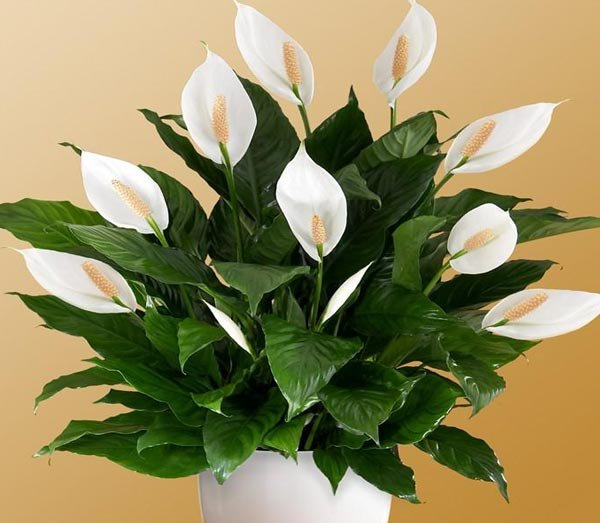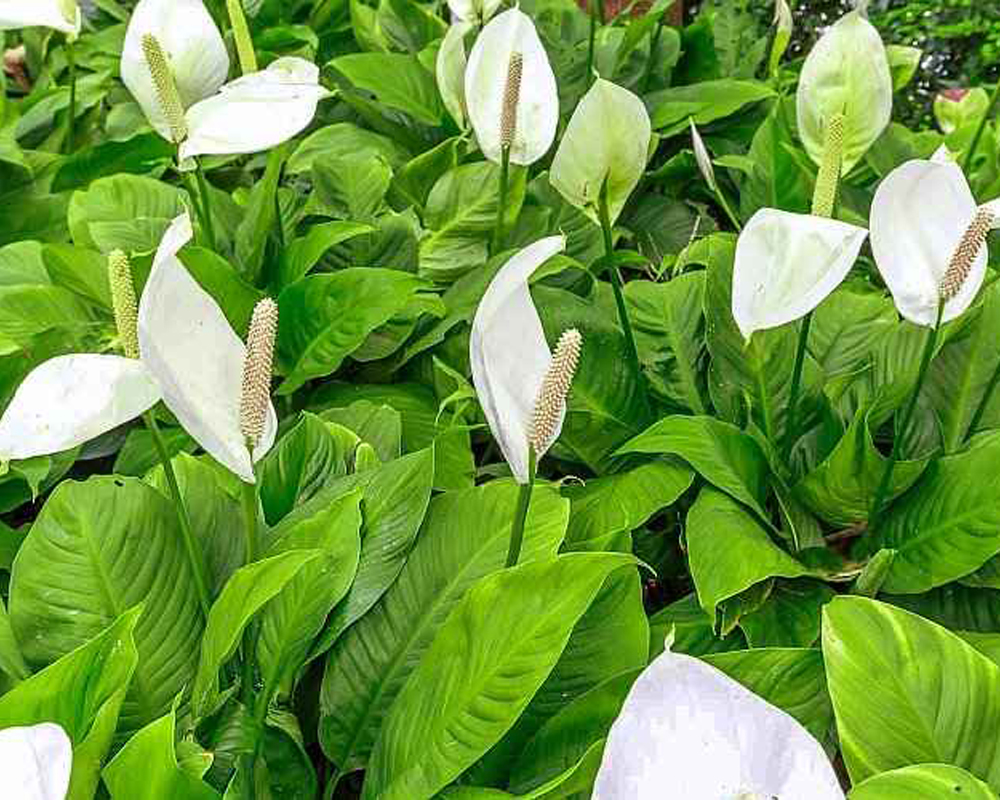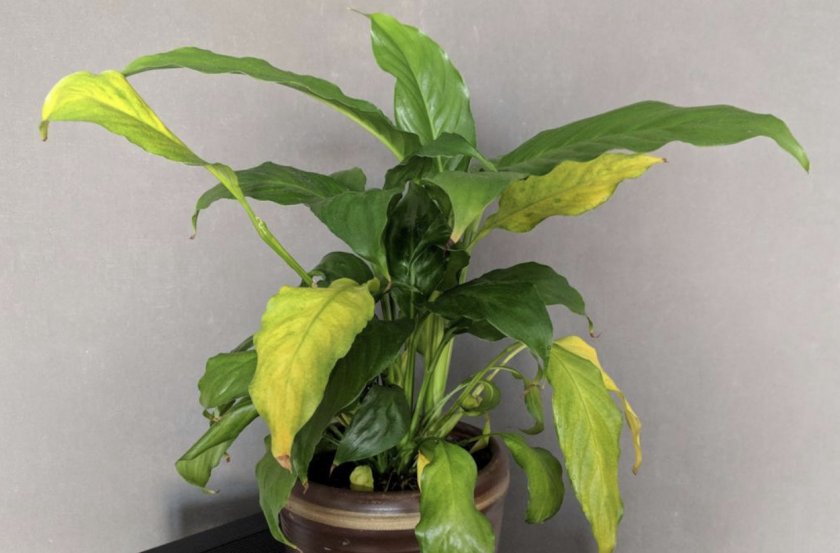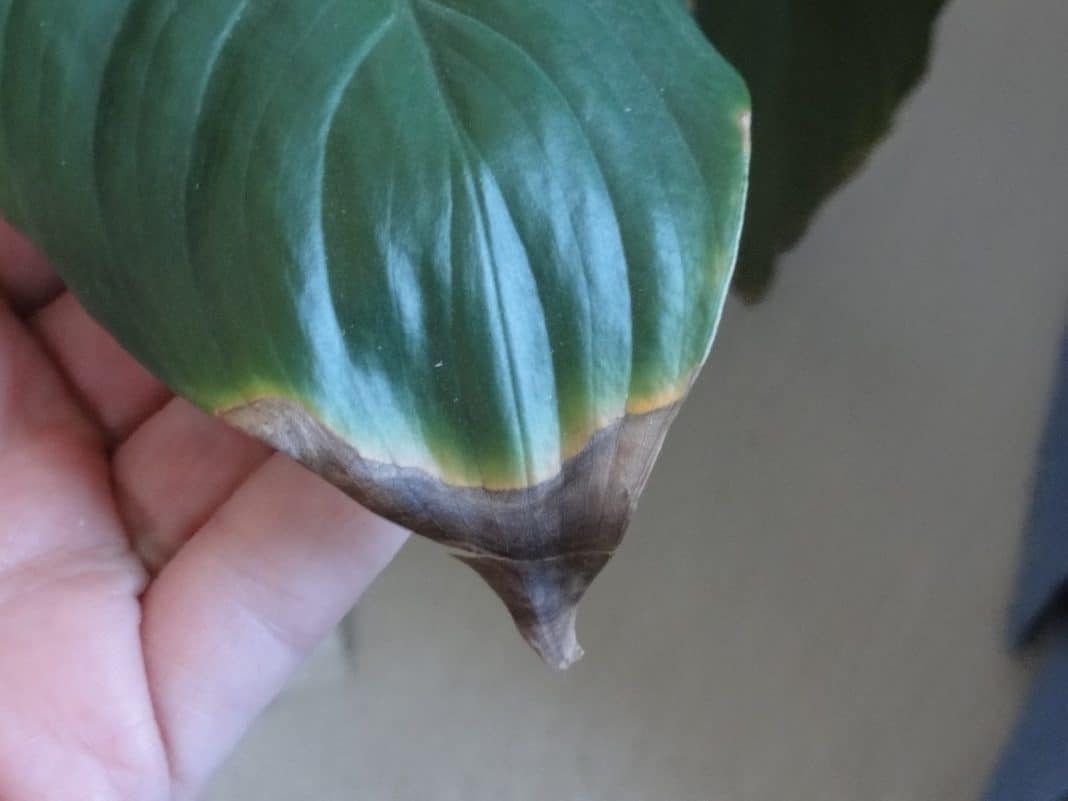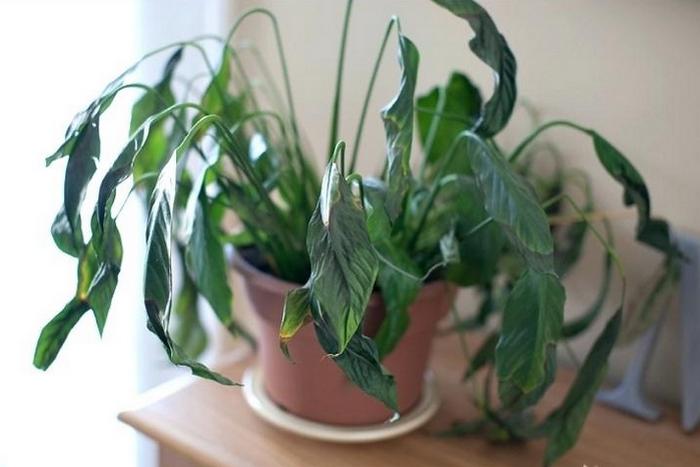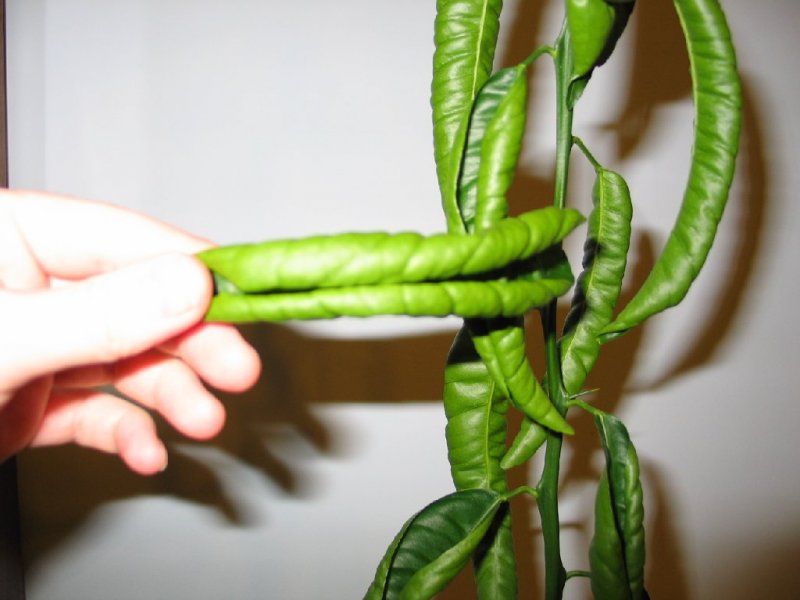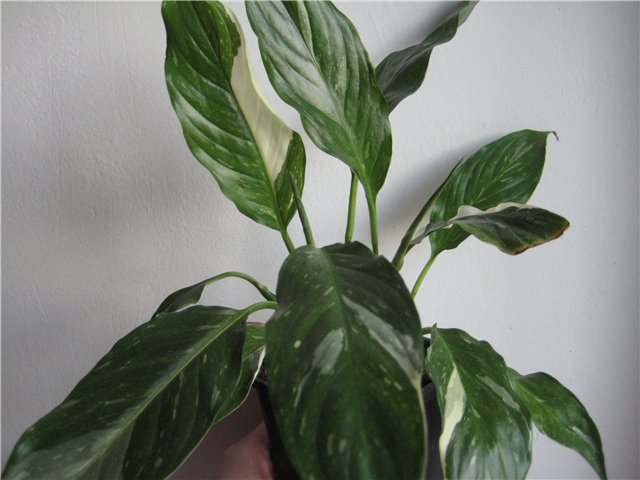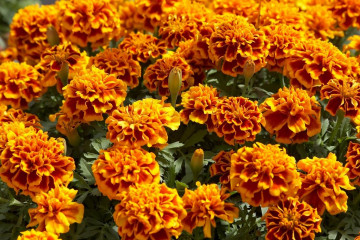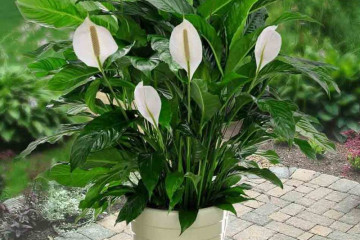Spathiphyllum - home care, why leaf tips dry
Content:
A very spectacular plant "female happiness" can cause the hostess to worry. The leaves become pale, lethargic, then yellow or even black, they can wilt, curl and dry out altogether.
What can be done, how to reanimate and save a favorite plant at home, all flower growers must know about this.
Spathiphyllum at home
Spathiphyllum (in Latin spathiphyllum) represents the Aroid family, uniting 45 species. In natural conditions, it is found in the tropics, forest nature in Brazil, Venezuela and the Philippines. The name is derived from the Greek "spata" and "phillum" - "veil" and "leaf".
It is a perennial plant that is considered stemless. The leaf begins its growth right from the root and can raise oval or lanceolate leaves up to 80 cm in height. In the spring it begins to bloom, the bush is covered with inflorescences in the form of a cob, covered with a green "blanket". After the flowering period, the peduncle must be cut as low as possible.
Features of growing at home:
- Transfer. The procedure is carried out very carefully so that the root system is not damaged. It is best to transplant the plant in the spring, when the flower is crowded in the pot. Prepare the necessary soil (in equal proportions of humus, peat, deciduous and river soil) and a container larger than it was. A drainage layer is laid at the bottom of the container, after which it is worth lowering the spathiphyllum and adding the prepared soil, tamping and loosened a little. At first, spray the transplanted flower and water well.
- You can feed it both in winter (if there are flowers), and in the period from early spring to October. A mineral fertilizer is used in the form of a solution of weak concentration (a liter of water and 1-1.5 grams of fertilizing).
- Lighting. The best choice is a south-facing window sill. Be sure to protect from direct sunlight. In diffused light, the shrub retains inflorescences longer. In the dark, the leaves begin to darken, become burgundy-green, you can never wait for flowering.
- Temperature. Satisfies in the range from +18 to +23 degrees. With a decrease to 10 degrees and below, inflorescences begin to wither, yellow leaves appear, and later rot. As a result, the plant withers. Spathiphyllum can also die with excessive drafts.
- Watering must be done with water that has settled for 24 hours. The substrate should never dry out, so watering should be very abundant, especially in summer or spring. Also, the soil must be loosened so that there is no stagnation of water. With a lack of moisture, the foliage can wither and subsequently will gradually dry out, with an excess, the foliage will be covered with spots of a dark color.
The reason for the yellowing of the leaves, how to eliminate
If spathiphyllum leaves turn yellow, what is the reason, and how can the plant be revived?
Why the leaves of a recently healthy spathiphyllum turn yellow is sometimes not clear even to experienced flower growers. Yellowing occurs quickly and indicates the presence of a variety of problems. Most of the symptoms are similar, so the likelihood of a wrong diagnosis is high. However, it is impossible to hesitate with the treatment - the plant will die.
Causes and methods of treatment:
- Leaves can turn yellow from lack of attention to the plant. For example, there was an active flowering period, and the spathiphyllum was simply tired. With this option, the lower tier of foliage quickly turns pale, withers and withers. The first help for a tired flower will be feeding and, if possible, transplanting into a wider pot with loose soil.
- Uncomfortable lighting. Most likely, the plant was exposed to direct sunlight for a long time. Despite the fact that Spathiphyllum loves light, the summer sun can cause burns on the plates.
- Excessively dry air, especially in winter when heating is on. There will be different options to help with this problem: remove the flower away from the battery, place a container of liquid near it, use an air humidifier and spray the plant more often.
Causes of blackening of leaves at the edges, how to eliminate
Spathiphyllum leaves turn black at the edges what to do, how to care and what treatment to take for this disease?
The reasons why the tips or plates of leaves turn black in spathiphyllum are:
- Overdoing it with feeding. It is important to adhere to the dosage prescribed for the mineral fertilizer.
- The roots began to freeze. The plant loves the tropics, in those conditions the temperature does not drop below 15-18 degrees.
- There is not enough air humidity. At the first stage, the leaves turn yellow and dry, after a long period of drought they turn black. It is recommended to water and spray the plant abundantly all year round.
- Severe sunburn. Damaged foliage should be removed, the plant should be urgently rearranged in a semi-dark place.
- Wrong substrate. A prerequisite for good flower growth is loose soil. If it is too dense, then the moisture stagnates, then rot appears at the roots, after which the leaves turn black.
- Too much moisture in the soil. The best solution is to wait until the top layer of the substrate dries. In summer, watering is done every 3-4 days, in winter, during the dormant period, even less often.
Causes of dry leaf tips, how to eliminate
There are frequent requests to specialists: "Spathiphyllum home care why are the tips of the leaves dry?" The reasons may be the following:
- Not enough moisture. At first, the foliage begins to brighten and turn yellow quickly, after which it also dries rapidly. Dry air is very destructive for a flower, because it comes from a tropical marine climate. To compensate for the lack of moisture, leaves are wiped from dust and sprayed from a spray bottle. You can also install the pot on a pallet, which is filled with drainage mixture (sand, pebbles, expanded clay) and filled with water.
- Too much moisture. Oddly enough, but due to this reason, the tips of the leaf also dry. The mistress, believing that the flower needs abundant watering, can provoke its stagnation by excessive moisture. As a result, the roots do not cope and begin to rot, and the leaves dry out. Better to put a layer of moss moistened with water in a pot or take a double container. The flower is placed in a large container, wet peat is placed in the space between the two containers.
- Improper feeding. Most likely, the plant lacks minerals.It is worth adding nitrogen, potassium and phosphorus to the soil.
- Bad place for a flower. Check if the flower is standing in the scorching sun or, conversely, is overcooled.
The cause of curling leaves, how to fix
It happens that the leaves of the spathiphyllum begin to shrink, the remaining foliage curl into tubes. The plant signals that it urgently needs care and a change in watering, nutrition, lighting regimes.
The reasons for this process are:
- Low air temperature. In addition to the fact that the foliage becomes too dark, burgundy-green, it also seems to be trying to "warm up", wrapping itself in a kind of cocoon. Perhaps the pot is on a windowsill where there are drafts or direct exposure to a fan flow.
- Lack of sunlight. This often happens during the winter cold or with constant rainfall. You can save the plant by installing a special UV lamp.
- Damage to the flower of aphids. As a matter of urgency, the whole plant is treated with a modern drug "Actellik", which is effective after the first exposure to the pest.
Causes of pallor of leaves, how to fix
Another result of improper care of spathiphyllum is the pallor of the leaves. They begin to turn pale at the very beginning of the disease, then the pallor is replaced by yellowness, black spots, rotting, drying and complete death of the plant.
First of all, it is necessary to correctly find out the cause of such a factor, since all the signs are similar to each other. If everything is done in a timely manner and efficiently, then the plant quickly returns to normal.
The flower becomes lethargic, the green color is lost - this is the first sign of the disease. After the leaf loses its turgor (elasticity), the first rudiments of yellowness appear.
The reasons may be:
- Watering is not done correctly (either too much moisture, or, conversely, not enough), or dry air,
- Fungal diseases
- Insect pests hit the plate,
- Lack of nutrition and minerals,
- The need for replanting due to overgrowth of roots or depleted soil.
Excess moisture is one of the most common causes of leaf discoloration. It is not so difficult to understand it: just touch the ground itself. It should be loose, light, moderately moist.
Diseases
Spathiphyllum is often affected by a fungus, their spectrum is very wide (the most popular diseases are rust and black spot). The fight against them, as a rule, is carried out with the help of fungicides. Moreover, you need to act quickly, and not wait until the flower completely withers away.
As soon as the leaves begin to wither, spots of gray, yellow or black appear, treatment begins. The affected areas are cut, the cuts are treated with activated carbon and potassium permanganate.All foliage is then treated with an anti-fungus agent with a chemical composition (can be purchased at any flower shop). In addition, the soil must change, since the fungus damages it too. In the course of treatment, preparations "Epin" or "Zircon" are added to the water for irrigation, they help to activate the remaining vitality.
Pests
The fight against pests is carried out in a somewhat simplified form: a simple laundry soap is enough. A warm solution of soap is made, after which the flower is completely processed. Do not forget also about the soil and even the windowsill, pot and pallet. The solution is left on the plant for about two hours, after which it is rinsed off abundantly in the shower. If there are a lot of pests, then folk remedies are unlikely to help. Then you have to fight with insecticides. They work very quickly and efficiently. It is worth repeating the treatment no earlier than after 5-7 days. Thus, time, effort will be saved, the life of the plant will quickly go back on track.
Spathiphyllum is not only a beautiful and elegant flower, but also a useful helper. It is known to destroy toxins, benzene and even formaldehyde. It is truly one of the brightest and most beautiful air purifiers. Therefore, there is no doubt that such a handsome man should be taken to your home or office.
